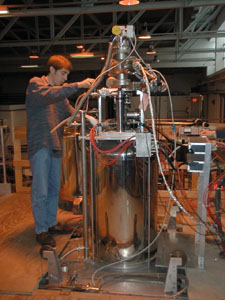
Tests of the Standard Model of particle physics are largely the domain of high-energy particle accelerators. However, a research programme recently inaugurated at CERN’s ISOLDE on-line isotope facility is demonstrating that low-energy experiments also have something to say – testing the Standard Model today, and looking for physics beyond it tomorrow.
Nuclear beta decay is nature’s way of redressing any uncomfortable imbalance between the number of protons and neutrons in a nucleus when either becomes excessive. It is a manifestation of the weak interaction, which acts over distances that are small compared with nuclear dimensions. That means that the nucleus can be used as a microlaboratory for investigating the weak interaction, thus putting the Standard Model to the test. ISOLDE is an ideal place for such research, because it is an abundant source of many isotopes with an uncomfortable mixture of protons and neutrons.
The nuclide chosen for ISOLDE’s Standard Model investigation is rubidium-74, which has equal numbers of protons and neutrons – an uncomfortable mixture in a heavy nucleus due to electrostatic repulsion – and is particularly suitable for the task. It decays with a half-life of around 65 ms to krypton-74 via a so-called super allowed Fermi beta transition in which only the vector component of the weak interaction is at work.
Nuclear beta decay, in which a neutron changes into a proton, is described in quark terms as the transition of a “down” quark to an “up” quark. The Cabibbo-Kobayashi-Maskawa matrix has three rows and three columns, which describe all possible quark transitions. Super-allowed beta decays give access to the up-down quark element, Vud, of the matrix. Combining Vud with the other elements, Vus and Vub, allows an important test (unitarity) of a Standard Model containing six quarks arranged pairwise in three generations.
Several experiments on relatively light isotopes have already given a very precise measurement. Curiously, these experiments are proving to be consistently at odds with the Standard Model, differing by more than two standard deviations.
The most precisely known of the three elements, Vud, also carries the most weight and, as such, is still the greatest source of uncertainty. This is due to the fact that the beta decay takes place in the nuclear medium, requiring theoretical corrections that must be constrained.
The precision expected from the latest ISOLDE experiments will allow the discrepancy observed in lighter nuclei, if confirmed, to be measured with greater significance and could therefore expose a small chink in the much vaunted Standard Model’s armour. The choice of rubidium-74 will also allow some important nuclear model distinctions to be made, because the heavier the nucleus, the more significant model-dependent Coulomb corrections become.
The ISOLDE experiments will explore three quantities involved in the decay of rubdium-74: the half-life and branching ratio of its super-allowed beta decay, and the mass difference between the parent and daughter nuclei – the Q-value of the decay. Experiments began in November 2000 using three different experimental facilities: the low-energy electron spectrometer ELLI, and the mass spectrometers ISOLTRAP and MISTRAL.
While MISTRAL was conceived specially for short-lived nuclei, the 65 ms half-life of rubidium-74 would normally have been far too short to be successfully measured by the tandem Penning trap spectrometer ISOLTRAP. However, recently developed ion-cooling techniques have allowed ISOLTRAP to extend its lower reach, thereby giving two independent measurements. In the game of high-precision mass determination, measurements by different instruments in the same regime of precision are important for cross-checking any hint of systematic error. ISOLTRAP has also succeeded in improving the measurement of mass of krypton-74, which further constrains the Q-value.
The new ISOLDE data are currently being analysed, with early indications suggesting small but significant deviations from previous mass values. The half-life of rubidium-74 is also the subject of similar studies at the Canadian TRIUMF laboratory’s new ISAC facility (March 2001 p10), the initial results of which have recently been published. The new ISOLDE spectroscopy results are in agreement with those of the ISAC facility, adding the equally important branching ratio measurement.
For the future, the ISOLDE programme aims to go one step further. Whereas ISOLDE today tests the Standard Model with rubidium-74, one of the first experiments scheduled for the REX-TRAP facility will use the nuclear microlaboratory to look for physics beyond the Standard Model. The WITCH experiment (Weak Interaction Studies Using an Electromagnetic Ion Trap), which is scheduled to run in 2002, will look for scalar and tensor components of the weak interaction – physics “forbidden” by the Standard Model.





